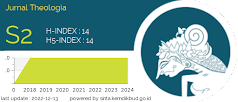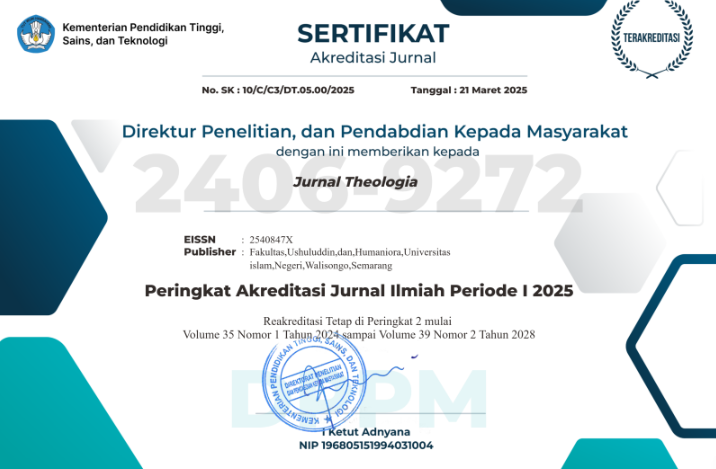MAHDIISME DALAM HADIS-HADIS MAHDAWIYAH
DOI:
https://doi.org/10.21580/teo.2019.30.2.3620Keywords:
mahdiism, Shi’ite followers, mahdawiyyah hadith, Ahl al-BaitAbstract
This paper discusses the origins of Mahdiism (al-Mahdi al-Muntaẓar) that are constructed using the mahdawiyyah ḥadīth with the status of aḥad (single transmitter) and ḍa'īf (weak). Nevertheless, this belief (Mahdiism) has deep roots in the theological reason of Muslims. By the historical approach, the finding shows that Mahdiism has roots in millenarianism (belief of the saviors' presence) that had existed in pre-Islamic traditions, such as Jewish and Christian. The elementary form of Islamic millenarianism is the concept of prophethood, but when the prophethood concept was deemed finished, it continued into the concept of Mahdiism. The first emergence of Mahdiism is in line with the emergence of mahdawiyyah ḥadīth. The emergence context of the mahdawiyyah ḥadīth revolves around the power transition from the Umayyad dynasty to the Abbasid dynasty, which always involved Shiite followers as the political victims. The contact between Shiites with the Jewish former and Christian former during the conflict at that time influenced the style of Shiite theology, like as millenarianism. The Shi'ites propagate the presence of al-Mahdi, as the savior from descendants of the prophet (Ahl al-Bait) described through the mahdawiyyah hadiths. Among the narrators of mahdawiyyah ḥadīth are Jewish former (Ka'ab al-Aḥbar) and Christians former (Wahb b. Munabbih). They were the pioneers who incorporated the millenarianism into the Mahdiism.Downloads
References
Abercrombie, Nicholas. The Penguin Dictionary of Sociology. England: The Penguin Books Ltd., 1984.
Abū Dāwud, Sulaiman ibn Dāwud al-Ṭayālisī al-Baṣrī. “Bāb al-Mahdi.” Dalam Sunan Abū Dāwud, Ed. Muḥammad ibn Abdul Muḥsin al-Turkiy. Mesir: Dār Ḥijr, 1999.
al-‘Amidy, Sayyid Ṭamir ‘Hashim. al-Mahdi al-Muntaẓar fī Fikr al-Islāmy. Qom: Markaz al-Risālah, 1425.
Amin, Aḥmad. Ḍuḥā al-Islām. Vol. 3. Cairo: Maktabah al-Nahḍah al-Miṣriyah, n.d.
Amīn, Aḥmad. al-Mahdi wa al-Mahdawiyah. Cairo: Muassasah Handawi li al-Ta’līm wa al-Thaqafah, 2012.
al-Asbaḥāni, Abū al-Faraj ‘Alī ibn al-Ḥusain. Kitāb al-Aghānī. Vol. 8. Cairo: Dār al-Ṭiba’ah al-Amiriyah, 1825.
Aziz, Abdul. Varian-Varian Fundamentalisme Islam di Indonesia. Jakarta: Diva Pustaka, 2004.
Aziz, M. Imam. “Memahami Gerakan Islam: Sebuah Agenda Untuk Indonesia.” Dalam Gerakan Sosial Islam: Teori, Pendekatan, dan Studi Kasus, Ed. Quintan Wiktorowicz. Yogyakarta: Gading Publishing, 2012.
al-Bayhaqī, Abū Bakr Aḥmad ibn al-Ḥusayn ibn ‘Alī. al-Sunan al-Kubrā. Makkah: Dār al-Bāz, 2003.
al-Bukhārī, Abū Abdillāh Muḥammad ibn Ismā’īl. al-Jāmi’ al-Ṣaḥīḥ li al-Imām al-Bukhārī. Beirut: Dār Ṭauq al-Najāh, 1422.
Brisbois, Michael J. “Millenarian Moderns: A Study of Utopian Desire.” University of Calgary, 2013. https://doi.org/10.11575/PRISM/26918.
Chon, Norman. “Milleniarisme Zaman Pertengahan: Hubungannya dengan Studi Komparatif Gerakan-gerakan Millenarian.” Dalam Gebrakan Kaum Mahdi: Studi tentang Gerakan-Gerakan Keagamaan Revolusioner, Ed. Sylvia L. Thrupp dan Tohiruddin Lubis, terj. Anas Muhyiddin. Bandung: Pustaka, 1984.
Clark, Martin. Antonio Gramsci and the Revolution that Failed. New Haven: Yale University Press, 1977.
Cook, David. Contemporary Muslim Apocalyptic Literature. Syracuse, NY: Syracuse University Press, 2008.
Cook, David. “‘Ḥadīth’, Authority and the End of the World: Traditions in Modern Muslim Apocalyptic Literature.” Oriente Moderno 21, no. 82 (2002): 31–53. https://www.jstor.org/stable/25817811.
Delitzsch, Franz. Messianic Prophecies in Historical Succession. New York: Charles Scribner’s Sons, 1891.
Doi, A. R. I. “The Yoruba Mahdi.” Journal of Religion in Africa 4, no. 2 (1971): 119–36. https://doi.org/10.2307/1594738.
Fanani, Muhyar. Metode Studi Islam; Aplikasi Sosiologi Pengetahuan sebagai Cara Pandang. Yogyakarta: Pustaka Pelajar, 2008.
Fathoni, Muslih. Paham Mahdi Syi’ah dan Ahmadiyah dalam Perspektif. Jakarta: Raja Grafindo Persada, 1994.
Filiu, Jean-Pierre. “The Return of Political Mahdism’.” Dalam Current Trends in Islamist Ideology, 8:26–38, 2009.
Garaudy, Roger. Zionis Sebuah Gerakan Keagamaan dan Politik. Terj. Moelia Radja Siregar. Jakarta: Gema Press Insani, 1995.
Glock, Charles Y., dan R. Stark. “On the Origin and Evolution of Religious Groups (1965).” Dalam Sociological Perspective, Selected Reading, Ed. Kenneth Thomson dan Jeremy Tunstall. Middlesex: Penguin Education, 1979.
Graaff, Bob de. “History of Fanaticism: From Enlightenment to Jihad.” Dalam AARHUS Lecture Series 2010, 2010.
Graff, Ronald Albert, dan Lambert T. Dolphin. Connecting the Dots: A Handbook of Bible Prophecy. Longwood: Xulon Press, 2010.
Hassan, Riffat. “Messianism and Islam.” Journal of Ecumenical Studies 22, no. 2 (1985): 261–91. http://soerenkern.com/pdfs/islam/MessianismAndIslamHassan.
pdf.
Humphreys, R. Stephen. Islamic History: A Framework for Inquiry. Revised. Princeton: Princeton University Press, 1991.
Ibn Ḥanbal, Abū ’Abdullāh Aḥmad ibn Muḥammad al-Shaibāni. al-Musnad al-Imām Aḥmad ibn Ḥanbal. Ed. Shu’aib Al-Arna’ūte. Beirut: Mu’assasah al-Risālah, 2001.
Ibn Khaldūn, Abū Zaid ’Abd al-Raḥmān ibn Muḥammad. “Bāb fī Amri al-Fāṭimī wa Mā Yaẓhabu ilaihi al-Nās fī Sha’nihi.” Dalam al-Muqaddimah li Ibn Khaldūn, Ed. ‘Abdullāh Muḥammad Darwis, Vol. 1. Damsyiq: Dār Yu’rab, 2004.
Ibn Khaldūn. The Muqaddimah: An Introduction to History. Ed. N. J. Dawood. Terj. Franz Rosenthal. Princeton: Princeton University Press, 2015.
Ibn Mājah, Abū ’Abdullāh Muḥammad ibn Yazīd al-Qazwīnī. “Bāb Khurūj al-Mahdi.” Dalam Sunan Ibn Mājah, Ed. Muḥammad Fuad ’Abd al-Bāqi. Cairo: Dār Ihyā’ al-Kutub al-Arabiyyah, n.d.
Ibn Abī Shaibah, Abū Bakar al-‘Abbasiy. Muṣannaf Ibn Abi Shaibah. Ed. Kamāl Yūsūf al-Ḥūt. Riyāẓ: Maktabah al-Rashd, 1409.
al-Khuzai, Abū ’Abdullāh Nu’aim ibn Hammad ibn Mu’awiyah ibn al-Harith. Kitāb al-Fitan. Ed. Samīr Amīn al-Zuhairi. Vol. 2. Cairo: Maktabah al-Tawḥīd, 1412.
Kuntowijoyo. “Sejarah Pemikiran.” Dalam Metodologi Sejarah. Yogyakarta: Tiara Wacana, 2003.
Livne-Kafri, Ofer. “Some Notes on the Muslim Apocalyptic Tradition.” Quaderni di Studi Arabi 17 (1999): 71–94. https://doi.org/10.2307/25802868.
Livne-Kafri, Ofer. “Some Observations on the Migration of Apocalyptic Features in Muslim Tradition.” Acta Orientalia Academiae Scientiarum Hungaricae 60, no. 4 (2007): 467–77. https://doi.org/10.2307/23658770.
Makin, Al. Nabi-Nabi Nusantara: Kisah Lia Eden dan Lainnya. Yogyakarta: SUKA-Press, 2017.
Makin, Al. Representing the Enemy: Musaylima in Muslim Literature. Frankfurt: Peter Lang, 2010.
Mālik, Muḥammad Maḥjūb. al-Muqāwamah al-Dākhiliyyah li Ḥarakati al-Mahdiyyah. Beirut: Dār al-Jail, 1987.
Muqtada, Muḥammad Rikza. “Radicalism in Islam: The Politicization of the Mahdawiyah Hadith among the Mahdi Movement.” Kalam 13, no. 1 (2019): 85–112. https://doi.org/10.24042/klm.v13i1.4069.
Murawiec, Laurent. The Mind of Jihad. 1 ed. Cambridge; New York: Cambridge University Press, 2008.
al-Nisāburī, Abū Abdillāh Muḥammad ibn ’Abdullāh al-Ḥākim. al-Mustadrak ‘alā al-Ṣaḥīḥaini. Ed. Muṣṭafā ’Abd al-Qādir ‘Aṭa. Beirut: Dār al-Kutub al-'Ilmiyyah, 1990.
al-Nisāburī, Muslim ibn al-Ḥajāj Abū al-Ḥasan al-Qushairī. “Bāb al-Imārah.” Dalam al-Musnad al-Ṣaḥīḥ al-Mukhtaṣar Ṣaḥīḥ Imām Muslim, Vol. 3. Beirut: Dār Iḥyā’ al-Turath al-‘Arabī, n.d.
Nahdi, Saleh Asyabibi. Imam Mahdi Atau Ratu Adil? Jakarta: Arista Brahmatyasa, 1992.
Powers, David S. Studies in Qur’an and Hadith: The Formation of the Islamic Law of Inheritance. London: University of California Press, 1986.
al-Qummi, Abū Ja’far Muḥammad ibn ’Alī ibn al-Ḥusain. “Naṣ Allāh swt. ’alā al-Qā’im as.” Dalam Kamāl al-Dīn wa Itmām al-Ni’mah, Ed. Ḥusain al-A’lāmi, Vol. 23. Beirut: Muassasah al-A’lāmī li al-Maṭbū’āt, 1991.
al-Rāzī, Abū Ja’far Muḥammad ibn Ya’qūb ibn Isḥāq al-Kulaini. al-Kāfi li al-Kulaini. Ed. Alī Akbar al-Ghifarī. Vol. 1. Teheran: Dār al-Kutub al-Islāmī, 1363.
Rahman, Fazlur. Islam. Chicago & London: University of Chicago Press, 1977.
Santosa, Nyong Eka Teguh Iman. Sejarah Intelektual: Sebuah Pengantar. Sidoarjo: UruAnna, 2014.
Saritoprak, Zeki. “The Mahdī Tradition in Islam: A Social-Cognitive Approach.” Islamic Studies 41, no. 4 (2002): 651–74. https://doi.org/10.2307/20837234.
Sulaiman, Rusydi. Pengantar Metodologi Studi Sejarah Peradaban Islam. Jakarta: Raja Grafindo Persada, 2014.
Tawakkal, ’Abd al-Fataḥ. “Ka’b al-Aḥbār and the Isrāiliyyāt in the Tafsīr Literature.” Montreal: McGill University, 2007.
Thrupp, Sylvia L. “Impian-impian Millenial di dalam Aksi: Laporan Mengenai Diskusi Konperensi.” Dalam Gebrakan Kaum Mahdi: Studi tentang Gerakan-Gerakan Keagamaan Revolusioner, Ed. Sylvia L. Thrupp dan Tohiruddin Lubis, terj. Anas Muhyiddin. Bandung: Pustaka, 1984.
Wattimena, Reza. Melampaui Negara Hukum Klasik (Locke - Rousseau - Habermas). Yogyakarta: Kanisius, 2007.
Wilar, Abraham Silo. “Muḥammad as Seal of the Prophets: The Question of Ideology in Majority Muslim, Ahmadiya Muslim, and Western Readings of Seal.” Penamas 27, no. 2 (2014): 137–148. http://blajakarta.kemenag.
go.id/journal/index.php/penamas/article/view/75.
Yaocof, Yehoiakin Ben. Concepts of Messiah: A Study of the Messianic Concepts of Islam, Judaism, Messianic Judaism, Christianity. Bloomongton, Indianapolis: WestBow Press, 2012.
Yazigi, Maya. “William F. Tucker, Mahdis and Millenarians: Shiʿite Extremists in Early Muslim Iraq (Cambridge: Cambridge University Press, 2008). Pp. 204. $96.00 cloth, $30.00 paper, $68.00 e-book.” International Journal of Middle East Studies 43, no. 3 (2011): 573–75. https://doi.org/10.1017/S0020743811000808.
Yousofi, Morteza. “Reading Robinson Crusoe from the lens of Islamic Utopianism.” International Journal of Applied Linguistics & English Literature 3, no. 2 (2014): 187–93. https://doi.org/10.7575/aiac.ijalel.v.3n.2p.187.
al-Ẓahabī, Shamsuddīn Muḥammad ibn Aḥmad ibn Uthmān. Talkhīs Kitāb al-‘Ilal al-Mutanāhiyah li Ibn al-Jauzī. Ed. Abū Tamīm Yasīr ibn Ibrāhīm. Riyāẓ: Shirkah al-Riyāẓ, 1998.




















